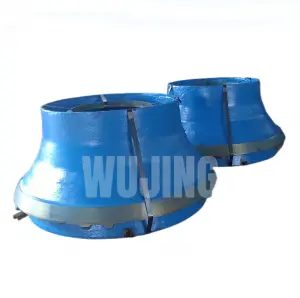The upper part of the movable jaw plate of the jaw crusher is connected with the eccentric shaft, the lower part is supported by the thrust plate, and the fixed jaw plate is fixed on the frame. When the eccentric shaft rotates, the movable jaw plate mainly bears the extrusion action of the material, while the fixed jaw plate mainly bears the sliding cutting action of the material. As a part with high rate of jaw breakage and wear, the choice of jaw material is related to the cost and benefit of users.
High manganese steel High manganese steel is the traditional material of jaw crusher jaw plate, has good impact load resistance, but due to the reason of the crusher structure, the Angle between the dynamic and fixed jaw plate is too large, easy to cause abrasive sliding, due to deformation hardening is not enough to make the jaw plate surface hardness is low, abrasive short-range cutting, jaw plate wear faster. In order to improve the service life of the jaw plate, a variety of jaw plate materials have been developed, such as adding Cr, Mo, W, Ti, V, Nb and other elements to modify the high manganese steel, and the dispersion strengthening treatment of high manganese steel to improve its initial hardness and yield strength. In addition, the composite of medium manganese steel, low alloy steel, high chromium cast iron and high manganese steel has been developed, and good results have been achieved in production.
China Manganese Steel was first invented by Climax Molybdenum Company and was officially listed in the United States patent in 1963. The hardening mechanism is as follows: after the reduction of manganese content, the stability of austenite decreases, and when subjected to impact or wear, austenite is prone to deformation-induced martensitic transformation, which improves its wear resistance. The usual composition of manganese steel (%) : 0.7-1.2C, 6-9Mn, 0.5-0.8Si, 1-2Cr and other trace elements V, Ti, Nb, rare earth and so on. The actual service life of medium manganese steel jaw plate is more than 20% higher than that of high manganese steel, and the cost is comparable to that of high manganese steel.
03 High chromium cast iron Although high chromium cast iron has high wear resistance, but because of its poor toughness, the use of high chromium cast iron as a jaw plate does not necessarily achieve good results. In recent years, high chromium cast iron or bonded to high manganese steel jaw plate to form a double jaw plate, the relative wear resistance of up to 3 times, so that the service life of the jaw plate significantly increased. This is also an effective way to improve the service life of the jaw plate, but its manufacturing process is more complex, so it is difficult to manufacture.
Carbon low alloy cast steel is also a widely used wear-resistant material, because of its high hardness (≥45HRC) and appropriate toughness (≥15J/cm²), can resist the material cutting and repeated extrusion caused by fatigue spalling, thus showing good wear resistance. At the same time, the medium carbon low alloy cast steel can also be adjusted by the composition and heat treatment process, so that the hardness and toughness can change in a large range to meet the requirements of different working conditions. The operation test shows that the service life of medium carbon low alloy steel jaw plate is more than 3 times longer than that of high manganese steel.

Jaw plate selection suggestions:
In summary, the selection of jaw plate material ideally to meet the requirements of high hardness and high toughness, but the toughness and hardness of the material are often contradictory, so in the actual selection of materials, we must fully understand the working conditions, reasonable selection of materials.
1) Impact load is one of the important factors that should be considered in reasonable material selection. The larger the specifications, the heavier the wear-prone parts, the more lumpiness of the broken materials, and the greater the impact load. At this time, modified or dispersion-strengthened high manganese steel can still be used as the object of material selection. For medium and small crushers, the impact load borne by the easy grinding parts is not very large, the use of high manganese steel, it is difficult to make it fully work hardening. Under such working conditions, the choice of medium carbon low alloy steel or high chromium cast iron/low alloy steel composite material can obtain good technical and economic benefits.
2) The composition of the material and its hardness are also factors that cannot be ignored in reasonable material selection. In general, the higher the hardness of the material, the higher the hardness requirements of the material of the easy-to-wear part, so under the condition of meeting the toughness requirements, the material with high hardness should be selected as far as possible.
3) Reasonable material selection should also consider the wear mechanism of easily worn parts. If the cutting wear is the main factor, the hardness should be considered first when selecting materials. If plastic wear or fatigue wear is the main wear, plasticity and toughness should be considered first when selecting materials. Of course, in the selection of materials, it should also consider the rationality of its process, easy to organize production and quality control.

Post time: Nov-21-2024
